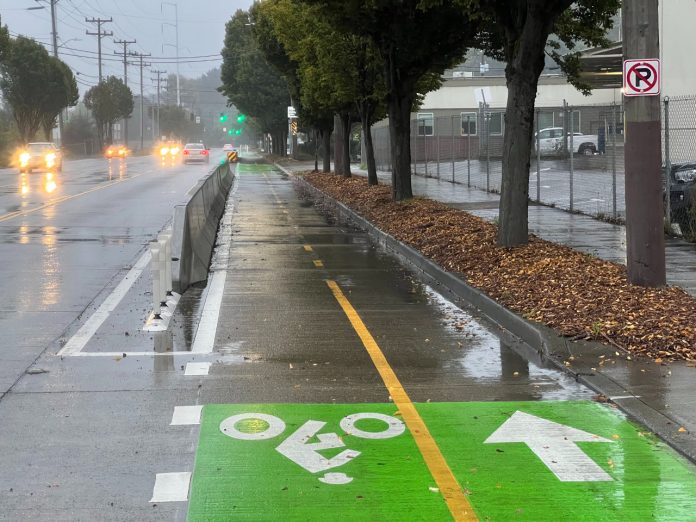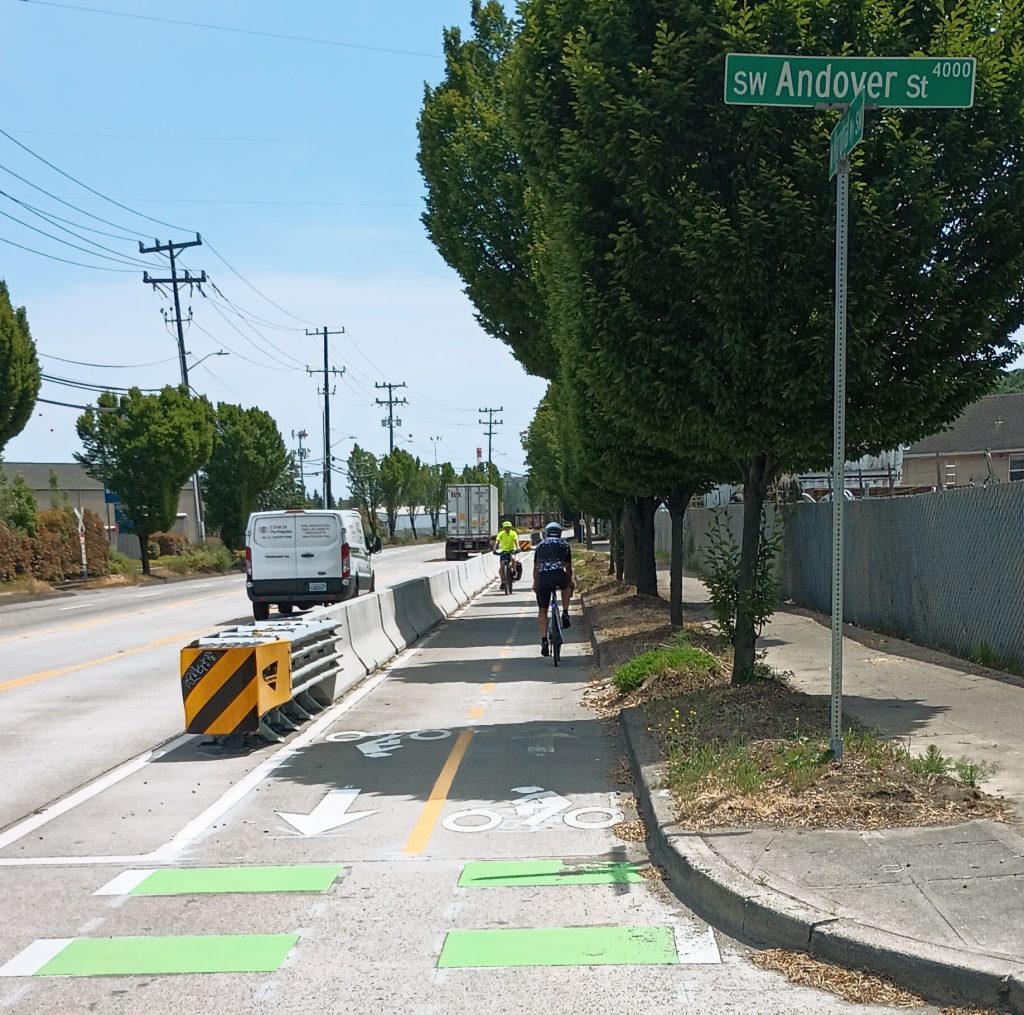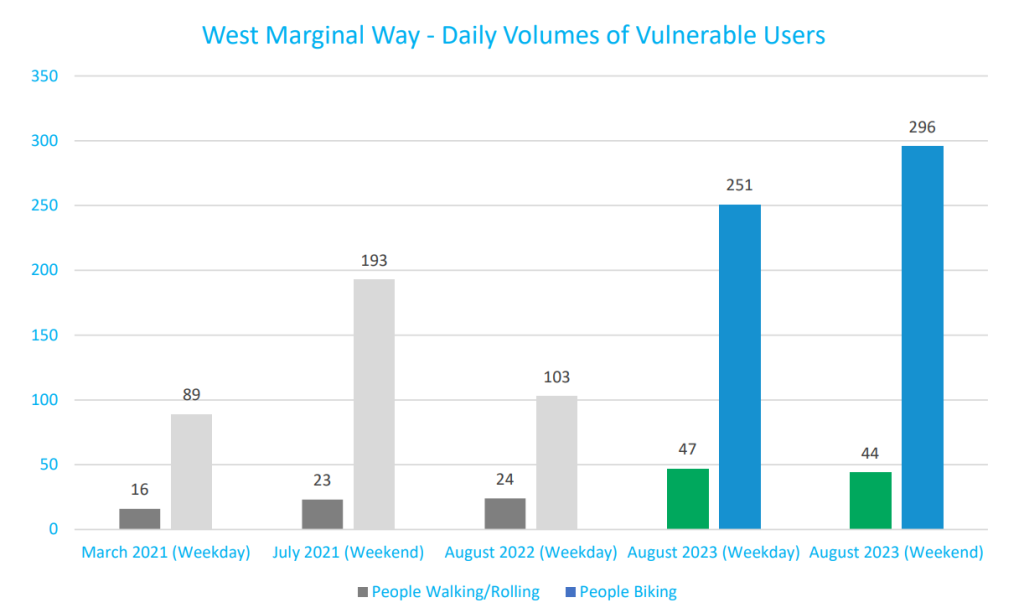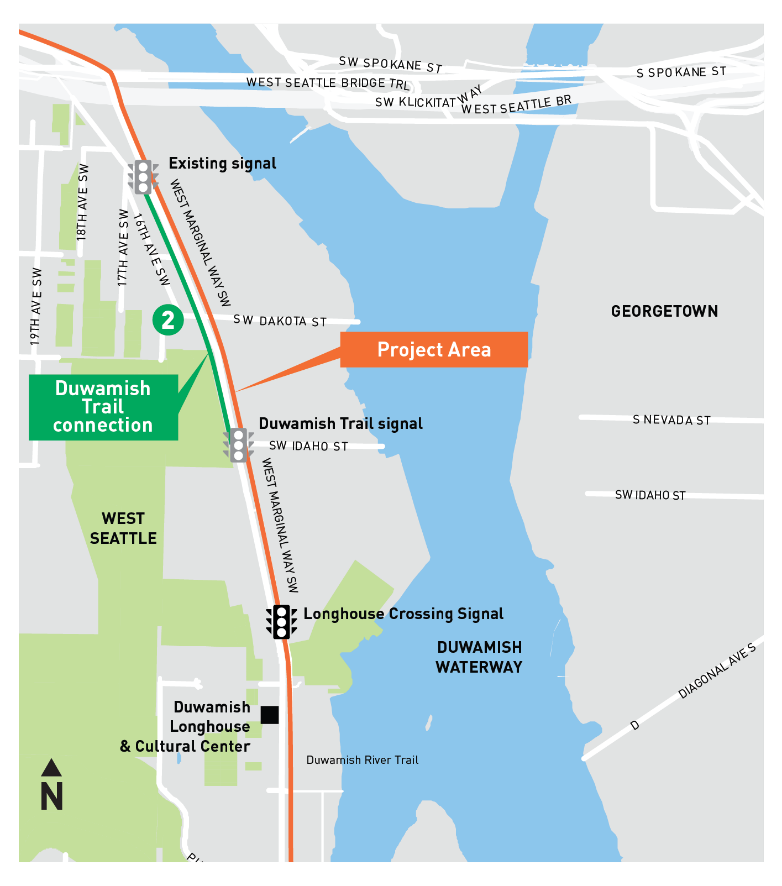
The installation of a protected bike lane on West Marginal Way SW, finally connecting the last gap between the Duwamish Trail and the West Seattle Bridge Trail, helped boost usage along the corridor by more than double, according to new Seattle Department of Transportation (SDOT) figures. Despite strong opposition from freight and business advocates, SDOT installed the 0.4 mile connection in April. The pushback did delay the project, with concerns over potential traffic impacts pushing it until after the West Seattle Bridge reopened in late 2022.
“The number of people walking and biking along the Duwamish Trail corridor has significantly increased,” SDOT’s Chief Safety Officer Venu Nemani told the Seattle Freight Advisory Board this week while delivering a promised assessment of the project. Yet the new facility only resulted in a one second difference in travel time for people driving on the street, suggesting that opposition to the project based on potential impacts on drivers was significantly overblown.
The data on the complete impact of the short bike connection has been outlined in a new report that SDOT released this week, and overall, it paints an extremely positive picture of the impact of the project.

The route in question is the most direct way to get between South Park, West Seattle, and downtown Seattle, but ever since the trail was completed in the early 1990s, a gap has forced people biking to use the narrow sidewalk at the north end of West Marginal Way. The new bike lane utilizes a former southbound traffic lane that previously existed north of a spot where traffic merges into one lane at the Duwamish Tribe’s Longhouse. In 2021, SDOT also installed a new traffic signal directly at the Longhouse and a new stretch of sidewalk nearby, making the area easier to navigate while walking or rolling.

The number of people biking along West Marginal Way on weekdays this past fall was up 144% over 2022 numbers, with weekend ridership up 53%. The number of people walking increased by 96% on weekdays and 91% on weekends. While the absolute numbers of people walking, biking, and rolling on industrial West Marginal remain relatively low compared to other high-use facilities elsewhere in the city, the significant boost in usage that was seen after implementing relatively low impact changes shows how space can be reallocated, even on major truck streets, for the benefit of all street users.
Despite concerns that additional walking and biking traffic on West Marginal Way would lead to an increase in the number of collisions, given the number of driveways along the corridor, Nemani reported this week that no collisions have been recorded involving people travelling outside of cars on the street following the installation of the bike lane, and a video analysis of traffic along the Duwamish Trail showed very few instances of potential conflicts between drivers and trail users. That data seems to disprove another major point used to push back against making the street more attractive to people walking and biking.
Finally, with the installation of a bike lane in what was previously used as a lane for speeding drivers to pass slower ones, a reduction in the posted speed limit on West Marginal Way, and the installation of speed radar feedback signs, SDOT saw a modest decrease in vehicle speeds on the corridor, ranging from 4% to 11% at different intersections.
The idea for finally making this connection happen came up during the initial weeks of the emergency closure of the West Seattle Bridge in early 2020. With significant amounts of detour traffic heading to West Marginal Way, and also a clear push to incentivize more walking and biking trips to reduce traffic on all detour routes, creating a safer and more pleasant experience along West Marginal made sense. But with the street’s status as a “major truck street,” per the city’s freight master plan, the idea of giving up additional space on the street turned the installation of a short stretch of bike lane into a yearslong battle.
“We are in deeply opposed to removing traffic lanes to add a protected bike lane on [West Marginal Way],” the Seattle Freight Advisory Board wrote in a letter sent to Mayor Jenny Durkan’s office in November 2020. “[The street] is the only four-lane, north-south arterial in West Seattle explicitly used for freight… The loss of any travel time on West Marginal Way is problematic.” The freight board’s position was backed up in meetings of the West Seattle Bridge Community Task Force, a group created to provide feedback on plans to deal with the ongoing bridge closure.

“We do have concerns, grave concerns, on behalf of the seaport,” Peter Steinbrueck, at the time, a Port of Seattle Commissioner, said in July of 2021. “The basic issue… is balancing bicycle safety — that’s number one — with freight mobility, and ensuring viable freight access through the corridor.” Steinbrueck pushed the city to pursue an alternative that included a fully off-street path behind businesses on Marginal Way, something that was never budgeted for and would have taken years longer to deliver on.
That September, an agreement signed between the Port of Seattle and SDOT providing funding for the repair of the West Seattle Bridge included a stipulation on West Marginal Way — the bike lane would not be installed before the bridge was open. Ultimately, that is what ended up happening, with installation this April even as the freight advisory board continued to raise concerns.
The big jump in usage on the corridor this year after it was installed suggests it could have actually provided a real option as an alternative to a car trip during the West Seattle Bridge closure, the purpose for which the project had been envisioned in the first place. But now, the project serves as a significant precedent for modifications to the city’s busiest traffic corridors that improve safety, improve mobility, and do it all without compromising the movement of freight.
Ryan Packer has been writing for The Urbanist since 2015, and currently reports full-time as Contributing Editor. Their beats are transportation, land use, public space, traffic safety, and obscure community meetings. Packer has also reported for other regional outlets including BikePortland, Seattle Met, and PubliCola. They live in the Capitol Hill neighborhood of Seattle.

